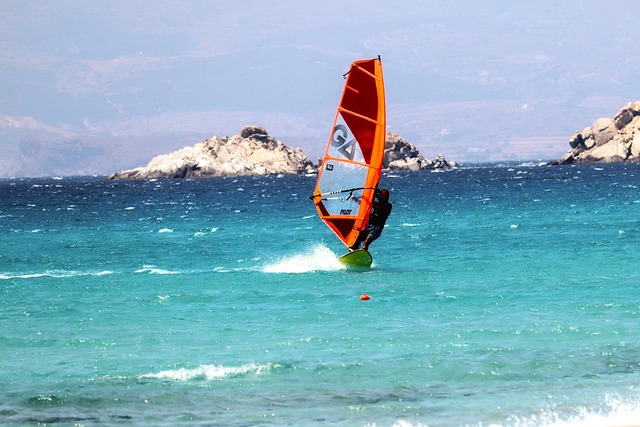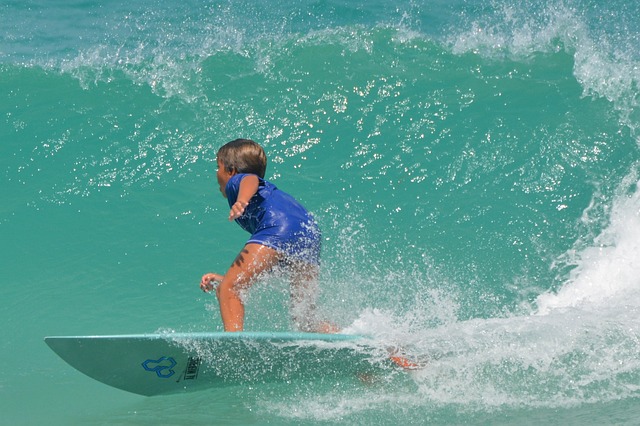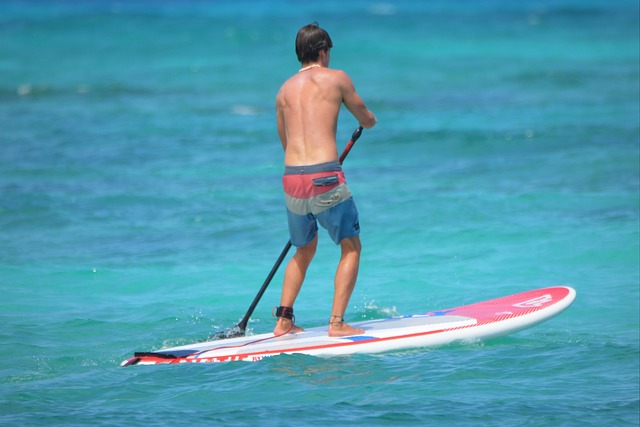When initiating into the world of surfing, selecting a beginner-friendly surfboard is paramount. A surfboard designed for novices should prioritize stability, ease of handling, and adequate floatation to manage the challenges of larger waves found in coastal environments. Optimal choices for beginners include the Softop Funsport and BIC SUP-02, which feature soft tops that resist dings and offer a secure grip. These boards are wider and thicker relative to their length, enhancing buoyancy and paddle efficiency, essential for catching waves. For those who prefer a classic longboard experience, models like the Classic Longboard offer larger dimensions that promote balance and a smoother ride, reducing the risk of falls. A higher volume board ensures better flotation and is available in various sizes to suit different rider sizes. As skills develop, one might consider a fin setup that suits their advancing abilities, with larger single fins or thrusters offering greater stability initially, transitioning to smaller, twin fins as proficiency grows. Additional equipment like a high-quality wetsuit, leash, booties, and surf wax are essential for safety and comfort. With the right surfboard and accessories, beginners can embark on their surfing adventure with confidence, setting the stage for progression and enjoyment in this dynamic sport.
Embarking on the thrilling journey of surfing can be both exhilarating and daunting. For those ready to ride the waves, selecting the ideal surfboard is crucial. This article guides novices through the essentials of coastal surfing, focusing on a surfboard for beginners that offers stability and ease of use. We’ll explore key characteristics of beginner-friendly surfboards, top models that cater to newcomers, and how to choose the right size and shape for your surfing style and physique. Additionally, we’ll highlight essential accessories that complement your new board and provide practical tips for practicing in coastal waters to advance your skills effectively. Whether you’re drawn to the ocean’s rhythm or seeking a new adventure on the waves, this guide will help you navigate the basics with confidence.
Understanding the Basics of a Surfboard for Beginners

When embarking on the journey into the world of surfing, selecting the right surfboard is paramount for beginners. A surfboard designed for novices should offer a balance between stability and maneuverability. Longboards are often recommended for those just starting out due to their size and shape, which provide more buoyancy and stability in the water. Their length allows for a smoother ride and makes paddling into waves easier, reducing the chances of frustration and injury as one learns the basics. The wider outline and rounded rails of longboards also contribute to their forgiving nature, making them ideal for practicing on smaller waves.
In addition to size, consider the volume of the surfboard. A higher volume board floats better and can accommodate a wider range of weights without sacrificing performance. This is particularly useful for beginners who are still honing their skills and may not have the strength to ride shorter, lower volume boards effectively. Soft tops are another important feature for new surfers, as they offer extra safety by eliminating sharp edges and providing a non-slip surface that reduces the risk of injury. When choosing a surfboard for beginners, it’s essential to select one that matches your height, weight, and skill level, ensuring a gentle learning curve and an enjoyable introduction to this exhilarating sport.
Key Characteristics of Beginner-Friendly Surfboards

When selecting a surfboard for beginners, it’s crucial to consider several key characteristics that will enhance the learning experience and promote progression in skill. The ideal beginner-friendly surfboard should have a design that offers stability and paddle power, which are essential for catching waves efficiently. A longer board typically provides more buoyancy and is easier to balance on, making it a popular choice among novices. The width of the board also plays a significant role; a wider board offers greater stability in the water, reducing the likelihood of falls and helping surfers to stand up with confidence.
Another important aspect to consider is the thickness of the surfboard for beginners. A thicker board floats better and can accommodate various body types without compromising performance. The volume of the board, which refers to its total float capacity, should be sufficient to support a beginner who isn’t yet skilled in wave reading and positioning. Soft tops are also a feature to look for as they provide a safe and comfortable surface to learn on, minimizing the risk of injury from impact with the board during inevitable wipeouts. Lastly, the shape of the surfboard should be user-friendly, with a rounded nose that softens impacts and a slightly lifted swallow tail which offers maneuverability without being too challenging for newcomers to handle. By focusing on these characteristics, beginners can choose a surfboard that complements their skill level, ensuring a more enjoyable and successful introduction to the sport of surfing.
Top Surfboard Models Ideal for New Surfers

For those embarking on their surfing journey, selecting the right surfboard is crucial for a positive learning experience. A surfboard designed for beginners should offer stability and ease of use while providing enough floatation to handle the occasional larger waves that coastal conditions may present. Models like the Softop Funsport and the BIC SUP-02 are standout options, offering soft tops that protect against dings and provide a comfortable grip even with wet suit hands. These boards are designed with a greater width and thickness relative to their length, which increases buoyancy and paddle power, making wave catching more accessible for novices. Additionally, the longboard surfboards, such as the Classic Longboard, are excellent choices for beginners due to their longer board shape that offers better balance and glide on waves, reducing the likelihood of falls and injuries. These beginner-friendly models are tailored to accommodate the learning curve while fostering an enjoyable introduction to the sport.
When considering a surfboard for beginners, it’s important to look at features like volume, which directly correlates with how much water the board can displace and thus how buoyant it is, ensuring that it floats well and is easier to ride. Models like the Guru Surfboards Foamie are designed with a high volume, making them perfect for those who are new to the sport and still mastering the basics. They also come in various sizes to accommodate different rider weights and heights. Another aspect to consider is the fin setup; boards with larger, single fins or thrusters provide more stability compared to smaller, twin fins, which can be more responsive as skill levels advance. Beginners will benefit from a forgiving board that can handle mistakes and help build confidence in the water.
Choosing the Right Size and Shape for Your Surfing Style and Body Type

When selecting a surfboard for beginners, it’s crucial to consider both your surfing style and body type to ensure comfort, control, and progression in the sport. The right size and shape of a surfboard can significantly impact your ability to learn and eventually ride waves with confidence. As a novice surfer, you should look for longer and wider boards with more volume, which provide greater stability and floatation. These features help in catching waves easier and offer the necessary support as you navigate through the initial stages of learning. The ideal surfboard for beginners typically measures between 7 to 9 feet in length, offering a forgiving platform to develop your skills.
In terms of shape, a softboard, often recommended for beginners, is designed with a rounded pin tail, making it less prone to pearling (nose-diving) and more forgiving when you don’t catch a wave perfectly. The width and thickness contribute to the buoyancy, allowing surfers of varying body types to paddle effectively without excessive effort. For larger or heavier individuals, a surfboard with additional volume will be more advantageous, ensuring that the board floats well and is easier to handle in the water. It’s important to experiment with different boards to find one that suits your individual needs and helps you enjoy the learning process without frustration. As you grow more comfortable and your skills advance, you can then consider a smaller, high-performance board tailored to your evolving surfing style.
Essential Accessories to Pair with Your Beginner Surfboard

When venturing into the realm of coastal surfing, particularly as a beginner, selecting the right equipment is paramount to a safe and enjoyable experience. A surfboard for beginners should be designed with stability and ease of use in mind, often characterized by a larger volume and a soft top for safety. Pairing this with the essential accessories will enhance your practice significantly. Firstly, a high-quality wetsuit is crucial to maintain warmth and comfort in the cool waters, as it provides insulation while allowing for a range of motion. A leash, which securely attaches your board to your ankle, ensures that you don’t lose your surfboard should you wipe out.
In addition to these, a pair of surf booties can protect your feet from sharp objects on the ocean floor and abrasions against the board during falls. A surf wax is another important accessory; it improves your grip by coating the deck of your board, making it less slippery. Sunscreen is also a must-have to safeguard your skin against harmful UV rays. Lastly, consider investing in a surfboard bag to transport your beginner surfboard safely and protect it from dings or damage during transit. With these accessories, beginners can confidently take on the waves, ensuring a comfortable and secure surfing experience.
Tips for Practicing on Coastal Waters and Advancing Your Skills

When practicing on coastal waters, selecting the right equipment is paramount, especially for beginners. A surfboard designed for novices will offer the necessary stability and buoyancy to master the basics without feeling overwhelmed. Look for a surfboard that’s longer and wider than average, as these features help maintain balance and floatation. Softboards, also known as foamies, are an excellent choice due to their forgiving nature and ease of use. They are typically more stable and have a softer finish, which minimizes the risk of injury when wipeouts occur.
As you gain confidence on your surfboard for beginners, it’s time to focus on advancing your skills. To progress, pay attention to your positioning on the board, as being in the correct spot can greatly influence your ability to paddle effectively and pop up smoothly. Practice paddling with a strong, steady stroke to generate enough momentum to catch waves. Additionally, work on your pop-up technique by mimicking the motion on dry land until it becomes second nature. Engage with local surf communities or consider lessons from experienced surfers who can offer personalized tips and feedback. By honing these skills in the coastal waters, you’ll be well on your way to becoming a proficient surfer, ready to ride the waves with confidence and control.
